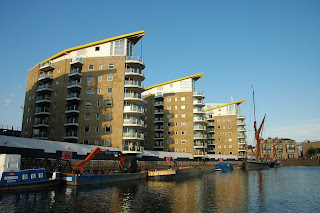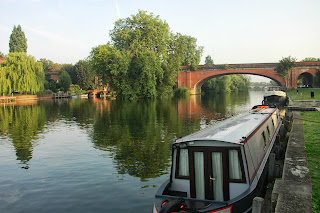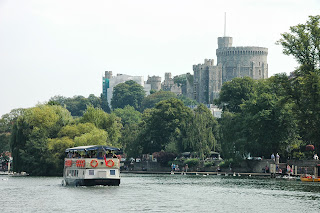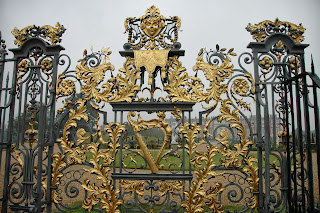Our regular travelling companions Sue and Martin have bought
a narrow boat this year and invited us with fellow Aussies Ian and Jan aboard
for an inland cruise. A few years ago we travelled West along the Kennett and
Avon canal so the plan this year was to go east, join the Thames and continue
via the London canal system to Olympic park. The relevant section of the inland
waterways map follows:
The first challenge was the 29 Caen Hill locks. The team looked
keen enough at the beginning of the 16 lock ladder.
Although beforehand some had to be cajoled from their
leisurely start.
Last year Sue was a little traumatised at the thought of owning and captaining a narrow boat, but now manoeuvrers it and barks orders to the crew as well as
any of us.
Not that life aboard was particularly onerous. Here we
decided the weather was so good we would breakfast ashore.
And lunch was no less tough
One of the attractions of travelling with Martin is his
knowledge of historical buildings. We stopped at Crofton pump station which was
built to pump water to the top of the Caen Hill pound. There are two large steam
driven pumps with 30 inch bores, an 8 foot stroke lifting 1.25 tons of
water each cycle. The lever arms between pump and engine are massive. They are
operated by volunteers every week or so and are apparently an awesome (noisy and steamy) spectacle.
The rest of the time the water is moved by a couple of small electric pumps –
how times have changed.
Our next bit of interest was from the same era. This is one
of only 4 horse drawn trip boats in England and the only one that goes through
locks. The horse was in its first year but wonderfully docile. The only thing
that phased him apparently was wild rhubarb – probably the elephants in them.
When arriving at a lock the horse was released and then the
two boat handlers took over. This was pretty hard human work getting the boat
started (while the horse walked by past the adjoining bridge). With two trips a
day 24/7 from March to Sept these guys were pretty fit.
The whole area was so picturesque.
As was the centre of Reading but very much 21st
C.
For those avid Grand Design watchers this is the house that
was built on the Thames on a very narrow block. Apart from the human and
physical challenges (eg building foundations under water) I think the final building works well with its
surroundings. The finish was of a high standard.
However, a few NIMBYs felt it detracted from the whole area.
It certainly contrasted with some older house and plot sizes.
Shortly after Reading we arrived at Henley the home of the
Oxford v Cambridge boat race. We saw many scullers in this area. It is a very
pretty town and we wondered around the market stocking up on cheese, pork pies
and stuffed olives.
There were also a number of
Kites in the area. This one was unusual with its “double diode” tail.
Meanwhile swanning around is not the only mood of the Queens bird. This one was constantly haranguing
and chasing another swan with the intent of mortally wounding it. Later a lock
keeper advised that he had to keep two pairs of swans either side of a lock to
stop them killing each other (notwithstanding it was not part of his job
description).
Our next overnight stop was adjacent to Brunel’s 1838
Sounding Bridge. This remarkable brick structure is the worlds flattest and
longest brick arch (128 ft long and only a 24 ft rise). At the time his sponsors
told him it would collapse and to leave the formwork in place. He did so but
only after dropping the formwork a couple of inches without their knowledge.
The formwork was later washed away in a flood and still stands carrying the
busy western railway line. Its subsequent widening used exactly the same
construction.
It also makes a beautiful picture frame.
From Reading we were on the Thames and all the locks were
manned during the working day and self service after hours. They have a best
kept lock competition and this one had to be close to winning.
Some
way upstream it became apparent that we were approaching Windsor
We went for a stroll around the town and our timing was
perfect as, after only a 10 minute wait, we caught the changing of the guard.
After Windsor came Runnymede which was the
birthplace of Magna Carta being formally confirmed
by King Edward 1 in 1297. The document “safeguarded constitutional rights
against unjust and arbitrary rule” and is
acknowledged as the start of Democracy. The Americans donated a memorial to
this effect.
Further up the hill was the Air Force memorial dedicated to
those who died in the second world war and whose remains where never found.
Although this had great views from the top of the tower these were overshadowed
by the thousands of names around the walls which made this a particularly
poignant memory.
Downstream we moored up at Hampton Court. Unfortunately the
rear gates had an additional fence in front
of them which made photography quite challenging. This side is the earlier
Baroque style designed by Christopher Wren.
The front is a little different…
As we approached London the canal adjoins Paddington railway
station. It is quite majestic despite numerous additions over the years and
now has modern entrances. In the alcove in front of the clock is the entrance to the
new cross rail which is due for opening in 2018. Should make crossing London by
train pretty quick.
Further down the “cut” things were definitely at a lot slower
pace in colourful Little Venice.
Parts of London came upon as at rapid intervals over the
last couple of days. We stopped at Camden markets which was both large and
brimming with people. The horse transport link between rail and canal has been
built on over the years and there are many sculptures of horses and related
gear in the market. In fact some of the décor is extraordinary such as this
canopy over the entrance to a railway arch shop.
Apart from the usual eateries and T shirt shops there were
some quite novel ones. These Garra Rufa fish apparently nibble away at the dead skin of
your feet. We decided not to give this a try in case it tickled too much.

We moved off the canal system at Limehouse basin and onto
the River Lea navigation. Some of the “bow” apartments in the area have great
South facing views.

Our final goal and destination was the Olympic village. Many
of the structures were being reduced in size to accommodate more usual
activities. This makes sense but not why the whole site has been sealed off
to the public including the canal system, for more than a year. Anyway here is a distant view of the
main stadium and ArcelorMittal's Orbit (frolic) behind.
We had a busy but great trip. It was not until I travelled
by train back to Caen Hill to pick up the car and then drove back that it
really underpinned how far we had gone. A big thank you to Sue and Martin for
their generosity in letting us travel in Braggabout as well as giving up
potentially a much more civilised pace of life to accommodate our requested whirlwind
schedule and route.






























No comments:
Post a Comment